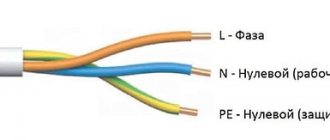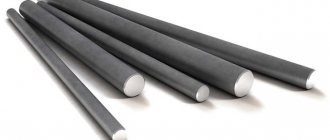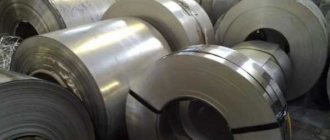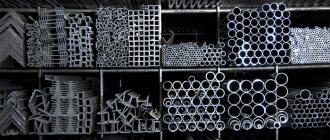Both stainless steel and galvanized steel are often used in the same industries, mainly as raw materials for the production of corrosion-resistant products, parts and assemblies of machines, installations and units. The main difference between stainless and galvanized steel lies , first of all, in the service life, that is, the period of time during which the material retains its anti-corrosion properties.
Given the significant difference in price between stainless steel and galvanized steel , it is possible that the buyer may be supplied with galvanized steel stainless steel .
How can you distinguish galvanization from stainless steel ?
The most accurate and reliable method is spectral analysis, determining the chemical composition of steel using special instruments. This method requires special equipment and time. However, there are simpler but less accurate methods based on the differences between stainless and galvanized steel .
The external differences between stainless steel and galvanized steel can provide a quick answer. Galvanized steel may have characteristic spots, known to many from galvanized buckets produced once during the Soviet era, the so-called crystallization pattern.
In addition, visually, stainless steel usually has a more matte surface than galvanized steel , especially if the stainless steel has not been subjected to a fine mirror finish. Galvanized steel without crystallization patterns almost always has a mirror surface, with a subtle bluish tint. However, with high-quality processing of stainless steel, for example, according to the BA standard, it is quite difficult to visually distinguish it from galvanized steel . If the sheet is thick enough, it would be useful to carefully examine the cut location for uniformity.
You can use the electromagnetic differences between galvanized and stainless steel . If a magnet is attracted to steel , then with a high degree of confidence we can say that it is galvanized steel , while most stainless steels and titanium alloys are not magnetic.
The chemical method, which uses hydrochloric acid, is based on the properties of zinc, which, when interacting with the coating of a galvanized sheet, actively releases hydrogen. A small drop of hydrochloric acid is enough for a chemical process noticeable to the naked eye to begin - the surface begins to bubble, the zinc layer gradually disappears.
And another way is to choose a reliable, trustworthy supplier of stainless steel and legally formalize the transaction.
When manufacturing metal containers or structures (for example, the widespread construction of hangars or warehouses), the quality of the metal, and, in particular, its corrosion resistance, is important. For this purpose, steels with protective (usually zinc) coatings, as well as stainless steel and aluminum are widely used. How can you distinguish between these metals and protect yourself from the actions of unscrupulous dealers?
Distinguishing aluminum from galvanization
In order to reduce the load on supporting structures, they are often made of aluminum. It is easy to distinguish aluminum from galvanized steel, especially if the buyer is not presented with a finished assembly, but with blanks made from rolled sheets or profiles. Main methods:
- By density/weight. The density of aluminum (2700 kg/m3) is almost three times less than the density of steel (7600...7900 kg/m3).
- In terms of surface hardness, aluminum is softer, and when scratched it will leave a deeper groove on a smooth surface.
- According to the effect on the tissue organs of the fingers. The thinnest film of aluminum dioxide upon frictional contact with wet skin of the hands will leave particles of aluminum on the surface of the fingers. When you touch them to a sheet of clean paper or cardboard, dark gray stripes will remain on it.
Externally, aluminum looks more silvery than steel, especially hot-rolled steel.
Which is better: black metal, galvanized steel or stainless steel?
Any manufacturer sooner or later is faced with the choice of material that best suits its requirements and budget. In this article we will look at the fundamental differences between black, galvanized and stainless steel, their corrosion resistance (the most frequently asked question) and give the estimated cost of each type of metal.
Black steel
Black steel
(colloquial ferrous metal, chernyaga) is an alloy of iron and carbon with a carbon content of up to 2%; with a carbon content of 2% to 4.5%, the alloy is considered cast iron. Depending on the proportion of carbon content in the alloy, steel is divided into: • Low-carbon (carbon fraction less than 0.25%) • Carbon (carbon fraction 0.25 - 0.6%) • High-carbon (carbon fraction more than 0.6%)
According to the method of obtaining rolled products, ferrous steel is divided into hot-rolled and cold-rolled. Their main difference is the processing temperature.
In the production of hot-rolled steel, low-grade steel is mainly used, due to which its cost is lower than cold-rolled steel. However, the thickness of hot-rolled steel in most metal warehouses varies from 3 mm to 160 mm.
Cold-rolled steel is widely used for metal structures that require thin sheet metal - from 0.4 mm to 3 mm; in some metal warehouses you can find sheet thicknesses up to 5-6 mm. Cold-rolled steel is considered to be of higher quality than hot-rolled steel, and therefore its cost is slightly higher than hot-rolled steel.
Black steel is often used in mechanical engineering, construction and industrial production.
We distinguish between galvanized and stainless steel
It is not easy to visually distinguish stainless steel from galvanized steel, since the difference in density is hardly noticeable (as is the appearance of the metal). The following types of tests must be used:
- For mechanical strength in the original state. Most grades of stainless steel have a tensile strength of at least 450 MPa. For galvanizing, this figure is much lower - up to 300...350 MPa.
- For hardness according to Brinell HB. For stainless steel, normal values are considered to be HB 230...300, for galvanized steel - HB 200...250.
- For plasticity. The specific force at which cracks appear on the workpiece is 170...230 MPa for galvanized steel, and 350...400 MPa for stainless steel.
If mechanical tests are not enough, chemical tests are carried out using hydrochloric acid. The method is based on the properties of zinc, which, when interacting with a galvanized sheet coating, actively releases hydrogen. A small drop of hydrochloric acid is enough for the galvanized surface to begin to bubble, and the zinc layer gradually disappears. The surface of stainless steel is chemically inactive.
Electromagnetic differences between galvanized and stainless steel can also be used for evaluation. If a magnet is attracted to the workpiece, then with a high degree of certainty we can say that it is galvanized steel, while most stainless steels are non-magnetic.
Corrosion irreversibly destroys any metal, due to which metal products completely lose their operational properties, turning into rusty dust and becoming unsuitable for use.
Fortunately, humanity has found effective ways to increase the corrosion resistance of metals - the most effective of them are alloying and applying protective coatings to the surface to prevent destruction.
Stainless steel vs galvanized: which is better?
Stainless steel and galvanization are almost Khabib and Conor in the world of corrosion control. Both cope with the tasks assigned as they should. This means there is a reason to compare and find out which is stronger.
In this article, we will understand why production features decide what is more durable, stronger, more environmentally friendly, cheaper, and which option is worth choosing.
How do stainless steel and galvanization work?
The differences between stainless and galvanized metal are associated with different chemical structures.
In fact, galvanized steel is an ordinary ferrous metal that is protected from corrosion only on the outside by a thin layer of zinc. Hence the name.
Most often, galvanizing is done this way: zinc is melted in a technological bath at a temperature of about 460 degrees and a steel sheet is immersed there. In air, molten zinc mixes with oxygen, and a thin film of zinc oxide appears on the metal surface. It protects it from corrosion in the future.
Hot galvanizing process for metal structures
Stainless steel is usually obtained using a more “hard” method. Depending on the grade of stainless steel, technological nuances may vary, but the general principle is production using an oxygen convector.
Molten cast iron is poured into the apparatus, alloying additives are added (the base is chromium; in addition, nickel, titanium, cobalt and other metals can be used). Oxygen is then introduced into the system. Next, a chemical reaction occurs. The carbon that is part of cast iron oxidizes and burns. Something like an “exhaust” appears - carbon monoxide.
After a time determined by the technology, the “excess” carbon burns out, and steel is obtained. And alloying additives provide high anti-corrosion properties. The fundamental difference is that the additives do not form a surface film, as is the case with galvanizing. They permeate the entire structure of the material, so damage to the surface layer does not lead to acceleration of corrosion processes.
Stainless steel smelting process
Which retains anti-corrosion properties longer
It is already clear from the previous subsection that the anti-corrosion resistance of stainless steel is higher. It’s one thing when only a thin layer of zinc protects from air, and quite another when the entire structure of the material is designed to interfere with the process of iron oxidation.
The maximum service life of galvanizing is significantly less than that of stainless steel:
- Service life of galvanized metal: 25 years.
- Service life of stainless steel: 50 years.
But in reality, galvanizing may be enough for a shorter period. The maximum durability of the surface is provided that paint is applied. In places where the paint is peeling or when there is mechanical damage to the surface, the service life is reduced.
Which is stronger
In all main strength characteristics, stainless steel is ahead of galvanized steel.
Tensile strength measures the ability of a material to resist stress before it breaks. Until the maximum load is reached, the material will “burst at the seams”, but will hold.
Tensile testing of a metal bar
Crack resistance is the maximum load that a material can withstand before its surface layer begins to collapse.
Hardness is the ability of a material to resist plastic deformation at the surface. The wear resistance of the material and resistance to mechanical damage depend on this parameter.
In these parameters, stainless steel is superior to galvanized metal. If the product operates under conditions of increased requirements for tensile strength, crack resistance and hardness, it is made of stainless steel.
Which is more environmentally friendly?
When galvanized is exposed to heat and comes into contact with acids, compounds hazardous to health are formed - zinc phosphides and oxides. These poisons can cause serious consequences: from stomach damage to nervous system paralysis and death. Therefore, galvanized steel is practically not used in the modern food industry.
Stainless steel under no circumstances forms compounds that could harm the health of people or animals, therefore it is optimal for the production of tableware and technological equipment for the food industry.
What is steel used for?
Today it is very difficult to overestimate the role of steel products in the life of modern society. Sometimes it’s enough to look around you, look at the metal household items that we use every day and think about what makes our life easier, more comfortable and more functional. You can find a large range of steel products in our catalog.
Steel underlies the activities of any manufacturing, industrial or construction enterprise - almost all mechanical, electronic and other products, as well as structures and devices with high strength and wear resistance, are made from it.
According to purpose, steel can be:
- Structural – designed for the manufacture of various mechanisms, structures and parts used in the construction of civil and industrial structures, as well as machine, instrument, ship and aircraft construction. Structural steel is an ideal base for sheet products, shaped products, fasteners, springs, rollers, membranes, plates and many others.
- Instrumental – used in the production of cutting, measuring and stamping tools.
- Special steels can be placed in a separate category - corrosion-resistant alloys with special physical and technical properties.
Characteristics of galvanized steel
No additional alloys are added to galvanizing, but rather it is coated with a layer of zinc. This coating creates a protective layer for the base steel and helps products cope with negative external factors that cause corrosion. The base metal does not come into contact with oxygen and liquids and is more resistant to mechanical damage.
Galvanizing is usually performed after the steel has gone through all technological processes. A layer of zinc is applied to one or two sides, depending on the product being manufactured or the technical specifications. Galvanizing is also applied to long and shaped steel. Zinc can be applied to finished metal structures and after manufacturing processes such as bending or welding.
What are stainless and galvanized steels used for?
Stainless and galvanized steel are products of development and modernization of the metallurgical industry. Due to their unique properties, these types of steel have a wide range of applications. Among the general advantageous characteristics of stainless steel and galvanization, it is necessary to highlight their high corrosion resistance and resistance to aggressive environments, which allows its use in industries that require good workability, exceptional strength and the ability to obtain reliable joints by welding.
Stainless and galvanized steels provide the user with the possibility of long-term operation without loss of quality characteristics and have an excellent appearance.
Galvanized or stainless steel: the difference in price pays off during operation
You can place an order by phone.
Our specialists will be happy to help you.
Galvanized and stainless steel have common properties of corrosion resistance and resistance to environmental influences, which makes the use of these types of metal popular in construction and industrial purposes.
Stainless steel
Stainless steel is a very practical material. Modern metallurgy offers a huge selection of steel grades that can meet a wide variety of conditions of use. The chemical composition of steels can vary and directly affects their physical and mechanical properties.
Today, almost all over the world, the AISI classification is used to distinguish between the characteristics of stainless steel (the abbreviation was first used by the American Iron and Steel Institute and is relevant for most manufacturers).
The materials of the 300 series are represented by grades that are austenitic steel with a fairly low carbon content. The grades have high corrosion resistance, as well as strength and ductility, and are easy to weld. They are used in the food, textile, pharmaceutical, chemical and paper and pulp industries, as well as in the production of equipment resistant to high temperatures.
The 400 series is a basic martensitic or ferritic stainless steel that has high toughness and heat resistance. Excellent for the production of cutting and measuring tools, springs, carburetor needles, piston compressor drains, parts of internal devices of devices and other various parts subject to wear in mildly aggressive environments. Steel grades of the 400 series are effective in arranging systems intended for pumping gas, oil and pure petroleum products.
Representatives of the 200 series have proven themselves well as a material for the manufacture of metal utensils, household kitchen utensils and apparatus. Also, steel grades of this series are used in the production of railings and stair railings.
Tips on how to distinguish galvanization from aluminum, stainless steel and non-galvanized steel
Since ancient times, iron has become the main metal for the production of a variety of things - from construction scrap to the finest mechanisms. To increase the strength and hardness of iron, they began to alloy it with carbon, producing the well-known steel. And to combat the main enemy of iron - corrosion - two main methods are used.
The first is the production of corrosion-resistant alloys, the so-called stainless steel. In addition to carbon, chromium is an important element in such alloys. The second method is to protect the metal surface with a special coating. Metals are usually used as coating materials, forming a protective film on the surface.
The most common material used for such purposes is zinc. Galvanizing is the process of coating steel products with a layer of zinc to protect against corrosion. Products made from this material are called galvanized. An alloy of zinc and aluminum, the so-called aluzinc, is also used for these purposes.
Advantages and disadvantages of galvanized pipes
Users include the following advantages of a galvanized chimney pipe:
- long-term immunity to corrosion;
- rapid heating of the chimney and, as a result, ensuring good draft;
- simple assembly method;
- a smooth surface inside the channel, which does not allow soot to linger on the walls;
- Possibility of venting through the wall of the building.
- short service life of a single-wall outlet;
- when cutting a product, the cut lines begin to rust after a short time;
- minor damage leads to the destruction of the protective layer;
- formation of a large amount of condensate.
Selection tips and approximate price
Manufacturers offer a large selection of both single-circuit galvanized bends and sandwich pipes with a galvanized shell. There are certain parameters by which you should select elements for the chimney:
- the diameter of the boiler outlet pipe must be equal to or less than the cross-section of the chimney outlet;
- attached chimneys can have no more than three bends along the entire length of the channel.
- Manufacturers indicate the required chimney diameter for boilers in the unit’s passport;
- The wall thickness for the outer casing must be at least 0.5 mm, usually 0.55 mm is used.
Stainless steel for centuries
The ability of steel with a high chromium content to resist corrosion was discovered at the beginning of the twentieth century. Since then, many types of steel have appeared, but chromium is still the main alloying element.
Stainless steel products are used everywhere - in construction, industry, household appliances, power generation, transport, and much more. Stainless steel sheets are often used to cover roofs and other parts of buildings - its anti-corrosion properties are very important here, given the variety of precipitation that the building receives.
Stainless steel is a very practical material. Available in a wide variety of brands, so it can suit a wide variety of conditions.
An interesting area of application for stainless steel, where it is practically irreplaceable, is the food industry. Stainless steel here meets high requirements for hygiene, aesthetics and toxicology. Also, the chemical and petrochemical industries and the production of household appliances are unthinkable without stainless steel.
How it is produced
Producing stainless steel is a very labor-intensive process. Stainless steel production technology involves a targeted change in its chemical composition by saturating the material with other elements, most often chromium (alloying), resulting in a product that is highly resistant to chemical and atmospheric corrosion. Due to the process of interaction with air, a film of insoluble oxides (chromium oxide) is formed on the surface of the steel, which protects the product from negative environmental influences.
Characteristics of stainless steel
Stainless steel differs from standard carbon or other types by the presence of certain additives in its composition. They are introduced into the material to change its chemical composition and make it more resistant to corrosion. Carbon steel is mainly composed of iron and carbon. And to get stainless steel, you need to add chromium and sometimes other alloying elements. Elements are added during the melting process and before molding. This changes the chemical properties. Alloying additives in stainless steel must be at least 12%. In addition to chromium, the structure of stainless steel is improved by nickel, cobalt, titanium, copper and other elements.
Difference between stainless and galvanized steel
Products made of stainless and galvanized steel do not have significant differences in appearance. An uninformed person may not even notice the difference and purchase galvanized steel instead of stainless steel from unscrupulous sellers. It should be noted that, despite the external similarity, the difference in price is quite noticeable. The high cost of stainless steel is justified by its longer service life, that is, the period of time during which the material will retain its anti-corrosion properties.
Stainless steel is not called the queen of steels for nothing. Despite its high cost, it has excellent characteristics that form its undeniable advantages: durability, ductility, environmental friendliness, hygiene, fire safety, high electrical conductivity, ease of processing and a very attractive appearance.
CORROSION RESISTANCE, PRICE, SERVICE LIFE OF CHERNYAGI, GALVANIZED, STAINLESS STEEL
The susceptibility of various types of metals to the corrosive effects of the external environment is determined by its chemical composition. The better the chemical composition and the higher the quality of the raw materials used, the more expensive it will cost.
1. CORROSION RESISTANCE
Black steel is most susceptible to corrosion
. If it is not additionally treated and coated with a protective layer, for example, paint, it will quickly rust and become unusable. The quality of the coating on black steel will also determine its service life. If you make a high-quality coating, for example, clean the metal, coat it with powder paint and bake it in a polymerization oven, the black metal can last a long time and may not suffer from minor damage. However, if the quality of the coating is questionable, for example, as when coating with spray paint, then with the slightest impact the paint can come off the metal and the steel will react with air and/or water, and rust will not be long in coming.
Cink Steel
, despite the zinc coating, can also be subject to corrosion. The better the coating, the longer the galvanization will last. Often, galvanized steel is coated with powder paint, which serves as double protection for the metal: the first layer is zinc, the second is paint.
Stainless steel
Different brands have different susceptibility to corrosion. Of the most popular grades of the 300 and 400 series, stainless steel of the 300 series has greater corrosion resistance (for example, AISI 304 12Х18Н10Т, GOST 5632). If you intend to use metal in an aggressive environment, you should not be fooled by the use of the word “stainless” in the name of the brands; you need to have an idea of the chemical composition of the metal and understand its features.
By price
Of the listed materials, the cheapest option would be
black steel
.
The next most expensive option is galvanized steel
and the most expensive option would be
stainless steel
.
As an example, we give the approximate cost of 1 kg of each material (as of September 2022): – black hot-rolled steel – 46 rubles/kg – black hot-rolled steel – 50 rubles/kg – galvanized steel – 68 rubles ./kg – stainless steel 304 series – 230 RUR/kg – stainless steel 430 series – 160 RUR/kg
Stainless steel products
Thanks to the unique qualities of the alloy and high aesthetic values, stainless steel products have always been in high demand, not only in industrial sectors, but also in everyday life. The modern metallurgical industry offers a huge range of stainless steel products:
- Equipment for food production.
- Furniture.
- Fittings – sheets, round and profile pipes, circles.
- Tanks, containers, trays.
- Parts and parts blanks - transitions, tees, plugs, dampers, valves.
Stainless steel is used in construction, energy and mechanical engineering to create high-precision elements. Most manufacturers offer custom manufacturing of any stainless steel products.
What is the difference between stainless steel and galvanization - Metals, equipment, instructions
It is no secret that the use of stainless steel (or stainless steel) in the modern world is of high importance.
And this is not surprising, because thanks to its excellent physical properties and resistance to external influences, steel is used everywhere. In construction, stainless steel has become popular primarily due to its strength, since stainless steel copes perfectly with this key requirement.
Advantages of stainless steel:
- - high corrosion resistance,
- - high strength,
- - resistance to aggressive environments,
- - plasticity.
What is the difference between stainless and galvanized steel?
Stainless steel contains alloying additives, such as chromium. It is thanks to this component that the material is resistant to corrosion.
When chromium reacts with oxygen, a special oxide film is formed on the surface of the steel, which has the ability to self-heal after minor mechanical damage. This is why stainless steel is able to retain its anti-corrosion properties much longer than galvanized steel.
Also note that the surface distinguishes stainless steel from galvanized steel - usually stainless steel has a more matte surface than galvanized steel, especially if the stainless steel has not been subjected to mirror processing.
Steel group 300
Stainless steel has a wide category of groups, of which the widest and most popular group is steel 300. All steel products in this group are endowed with ductility, strength, as well as high corrosion resistance due to the content of nickel and other components too.
AISI 304 steel (or its Russian analogue 08Х18Н10) is the most universal in use and the most in demand in all areas of industry among the existing grades of this group. You can also find the name 304 steel as food grade stainless steel, because in its chemical. composition and properties are most suitable for the food industry.
This brand has high corrosion resistance in highly aggressive environments and is easy to weld. Used in the chemical, pharmaceutical, petroleum and textile industries.
Products from AISI 304 "Stalprom"
can always supply perforated stainless steel sheets, products made from it, as well as stainless steel sheets and rolls of AISI 304 steel and other grades.
You can ask the necessary questions or send a request for material at the following coordinates, 8 (812) 313-25-01, e-mail: [email protected]
In what cases is a galvanized chimney pipe used?
Heating a private home » Chimneys
Finished pipes
Before installing a fireplace or stove at home, it is necessary to solve the problem with the removal of fuel combustion products. A chimney is provided for this purpose. It can be installed using ready-made structures, for example, a galvanized chimney pipe. It has its own characteristics, advantages and disadvantages, so it doesn’t hurt to find out as many details as possible about this technical unit.
A few words about galvanized pipes
Practice shows that a galvanized chimney pipe significantly outperforms its brick, ceramic and steel counterparts.
During the combustion of any type of fuel, gases are formed, which, passing through the chimney, cool and turn into condensate.
Moisture itself is destructive to brickwork and metal, but the situation is aggravated by the fact that dew contains carbonic and sulfuric acid.
They produce oxide, which, accumulating, gradually destroys any chimney walls. In the inner part, drips often form, and roughness appears, to which fumes and soot begin to cling. And this is dangerous because the draft decreases, as a result of which carbon monoxide enters the room through the firebox, creating a threat to human health.
Regular cleaning saves the situation, but not for long. And all because it is not possible to completely get rid of condensation. So experts initially recommend choosing chimney designs that, during operation, form a minimum amount of chimney. One such installation is a galvanized chimney pipe.
What are the operational benefits of this choice?
The main advantage of using the described option is the presence of a protective layer. Any metal that comes into contact with condensation begins to rust.
This is what causes the chimney to leak and reduce its efficiency. But if the metal is reliably protected from moisture, the entire structure will serve properly for quite a long time.
That's why galvanized chimney pipes have become so popular in recent years.
For its manufacture, durable sheet steel is used. Before creating the mold, it is dipped into a liquid solution of molten zinc. Both elements enter into a chemical reaction, during which the molecules of steel and zinc interact with each other.
This makes it possible to form a very thin but reliable protective layer, the thickness of which does not exceed 60 microns. This layer is sufficient to protect the steel and allow products made from it to serve for a long service life.
Chimney elements
If chimneys are made from such material, they acquire a lot of advantages:
- The design of the finished chimney consists of several parts, which are not difficult to put together.
- Any galvanized pipe is fire-resistant and fireproof, which is very important for buildings made of wood.
- The described chimney can be installed on almost any fireplace and stove equipment. Versatility is one of its most valuable positive qualities.
- The steel structure heats up very quickly, so traction is formed almost instantly. Thanks to this, the heating equipment itself operates more efficiently.
Existing varieties
Galvanized steel chimneys are available in a wide variety. Some models have a layer of insulation, which provides them with additional operational advantages. Therefore, for any installation it is easy to choose single-wall or double-wall chimney structures.
Elbow Ø100 mm 90 degrees
As a rule, the former are used when galvanized pipe is installed indoors or in masonry. They consist of several elements, which include bends, tees and revisions.
It is not advisable to use this option outside. After all, thin metal in the cold promotes the formation of abundant condensation.
Therefore, for external installation, models with insulation are most often used - double-circuit chimneys, or, as they are also called, sandwich pipes.
They have a multilayer structure, an outer and an inner body, between which a layer of insulation is laid. It is thanks to this unusual device that condensation formation is minimized. In addition, the insulated condensate pipe has a rather attractive appearance that harmonizes well with any modern facade.
Single-wall and double-wall chimneys made of galvanized steel - what are good and what are dangerous
The time when a brick chimney or asbestos pipe was traditionally used as a smoke removal system is long gone.
At the moment, many analogues have appeared (pipes made of stainless steel, ceramics, sandwich), which are superior to the latest options in technical and thermal insulation characteristics.
One of the possible options for arranging a smoke removal system is a chimney made of galvanized steel.
Can galvanized pipes be used for chimneys?
Making a chimney from galvanized metal is probably one of the most controversial decisions. On the one hand, this option is much cheaper than stainless steel analogues, on the other hand, there are fears (not without reason) that the use of galvanizing will affect the health of those living in the building. Before choosing a chimney of this type, you will need to take into account possible risks and nuances of operation .
Damage to galvanized chimneys
It is possible to use stainless steel galvanized pipes for a chimney, but you will need to take into account certain nuances related to the operation and characteristics of the metal. One of the reference books about galvanizing says the following:
- Heating zinc above 419.5°C is dangerous. At this time, especially in conditions of high humidity, metal oxide is formed. The fumes are poisonous and lead to severe poisoning.
- Pure zinc is not dangerous to human health and is found in the body: teeth, pancreas, blood, etc.
- Technical zinc is especially dangerous - during production, to give the metal the necessary technical characteristics, arsenic, antimony and lead are added to the impurity.
From all of the above, we can conclude that a galvanized chimney pipe can be safely used in smoke exhaust systems with low flue gas temperatures.
Sandwich-type structures, where the internal circuit is made of stainless steel and the external circuit is made of galvanized steel, have absolutely no impact on human health.
It is worth making a chimney from galvanized steel when connecting to heating equipment with a flue gas temperature of no more than 350°C. As a rule, it is safe to use the pipe in conjunction with gas appliances: water heaters, boilers and convectors.
Service life of a galvanized chimney
The service life of a pipe depends on many factors, but in general, a chimney can last up to 10 years without losing its tightness. To increase service life, you should adhere to the following recommendations:
- It is necessary to insulate a single-circuit galvanized chimney. Without thermal insulation, the pipe will not last long due to corrosion by condensate and burnout due to accumulated soot. Insulation of a galvanized pipe on the outer section of the chimney is a mandatory measure.
- Galvanizing paint significantly extends the service life of the product.
- The thickness of the steel used for the chimney must be at least 1 mm. Galvanization with a smaller thickness burns out quickly. On construction forums you can find information that this 0.6-0.8 mm material burned out after just six months of use.
What are they making, why from this particular steel?
Another area of application of stainless steel, which can be divided into a special category, is architecture, construction, decoration and the creation of unique design projects. The interior, which contains stainless steel elements, looks very elegant and stylish. In addition, steel combines perfectly with plastic, glass and wood materials.
Stainless steel has also found its application in the design of the exterior of buildings - steel railings and stainless steel fences have impeccable external characteristics, are weather-resistant, durable, and, as a result, safe and reliable.
engages in the development, manufacture and sale of stainless steel railings and stair railings. We invite everyone to the catalog of our website to familiarize themselves with the range of products offered and place an order:
- Railings.
- Balcony railings.
- Fencing for children's institutions.
- Fences for ramps.
- Fences with glass.
- Stainless steel railings.
- Wall handrails.
- All-glass fencing.
- Accessories for stainless steel fencing.
- Fence posts.
- Stainless steel pipes of various lengths and diameters.
will be glad to see you among its clients. We deliver high-quality stainless steel products throughout Russia.
Application of galvanized steel
Galvanizing, on the other hand, is often used in situations where corrosion is undesirable but small amounts are not critical. In these cases, the aesthetic component should also not be important, since galvanization does not always look beautiful. Places of use:
- Automotive technology.
- Structural beams.
- Housings for household appliances.
- Railing.
- Road signs.
- Electric poles.
- Ventilation systems.
- Profiled sheeting.
Both solutions are corrosion-resistant in their own way. When choosing, you need to evaluate the operating conditions of the products from all sides. In some places, cheaper galvanized steel will be suitable, but for critical facilities and complex operating parameters it is better to choose more reliable stainless steel, which will definitely pay for itself in the near future due to its durability.











